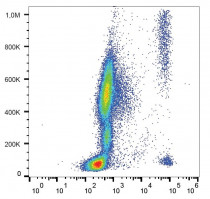ARG42451
anti-CD193 / CCR3 antibody [5E8] (PE)
anti-CD193 / CCR3 antibody [5E8] (PE) for Flow cytometry and Human
Overview
| Product Description | PE-conjugated Mouse Monoclonal antibody [5E8] recognizes CD193 / CCR3 |
|---|---|
| Tested Reactivity | Hu |
| Tested Application | FACS |
| Specificity | The mouse monoclonal antibody 5E8 recognizes an extracellular epitope of CD193 (chemokine receptor 3), an approximately 41 kDa protein expressed above all in eosinophils and basophils. |
| Host | Mouse |
| Clonality | Monoclonal |
| Clone | 5E8 |
| Isotype | IgG2b, kappa |
| Target Name | CD193 / CCR3 |
| Antigen Species | Human |
| Immunogen | Human CD193 / CCR3. |
| Conjugation | PE |
| Alternate Names | C-C chemokine receptor type 3; CD193; CKR3; CCR-3; Eosinophil eotaxin receptor; CMKBR3; C-C CKR-3; CCR3; CC-CKR-3; CD antigen CD193 |
Application Instructions
| Application Suggestion |
|
||||
|---|---|---|---|---|---|
| Application Note | * The dilutions indicate recommended starting dilutions and the optimal dilutions or concentrations should be determined by the scientist. |
Properties
| Form | Liquid |
|---|---|
| Purification | Purified |
| Buffer | PBS and 15 mM Sodium azide. |
| Preservative | 15 mM Sodium azide |
| Storage Instruction | Aliquot and store in the dark at 2-8°C. Keep protected from prolonged exposure to light. Avoid repeated freeze/thaw cycles. Suggest spin the vial prior to opening. The antibody solution should be gently mixed before use. |
| Note | For laboratory research only, not for drug, diagnostic or other use. |
Bioinformation
| Database Links | |
|---|---|
| Gene Symbol | CCR3 |
| Gene Full Name | chemokine (C-C motif) receptor 3 |
| Background | The protein encoded by this gene is a receptor for C-C type chemokines. It belongs to family 1 of the G protein-coupled receptors. This receptor binds and responds to a variety of chemokines, including eotaxin (CCL11), eotaxin-3 (CCL26), MCP-3 (CCL7), MCP-4 (CCL13), and RANTES (CCL5). It is highly expressed in eosinophils and basophils, and is also detected in TH1 and TH2 cells, as well as in airway epithelial cells. This receptor may contribute to the accumulation and activation of eosinophils and other inflammatory cells in the allergic airway. It is also known to be an entry co-receptor for HIV-1. This gene and seven other chemokine receptor genes form a chemokine receptor gene cluster on the chromosomal region 3p21. Alternatively spliced transcript variants have been described. [provided by RefSeq, Sep 2009] |
| Function | Receptor for C-C type chemokine. Binds and responds to a variety of chemokines, including CCL11, CCL26, CCL7, CCL13, RANTES(CCL5) and CCL15 (PubMed:7622448, PubMed:8642344, PubMed:8676064). Subsequently transduces a signal by increasing the intracellular calcium ions level (PubMed:8676064). In addition acts as a possible functional receptor for NARS1 (PubMed:30171954). (Microbial infection) Alternative coreceptor with CD4 for HIV-1 infection. [UniProt] |
| Cellular Localization | Cell membrane; Multi-pass membrane protein. [UniProt] |
| Calculated MW | 41 kDa |
Images (1) Click the Picture to Zoom In






